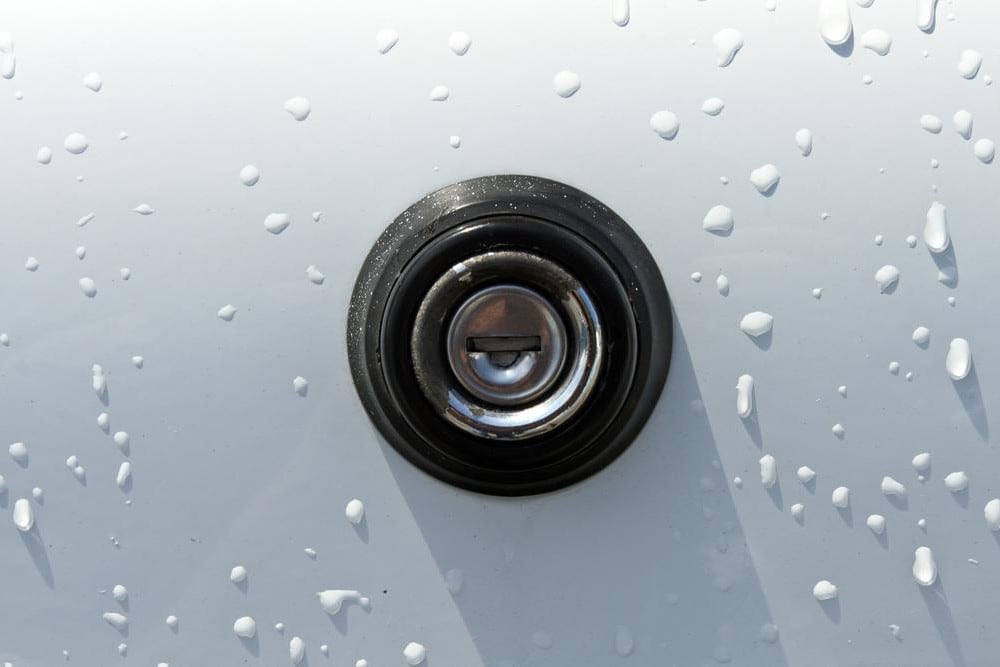

The trunk lock cylinder on your vehicle is responsible for triggering the latch mechanism that opens the trunk when you turn the key. A faulty lock cylinder can be a security issue for you and your car.
Follow the steps below to learn how to replace this part yourself. This guide is applicable to cars equipped with a trunk, but may also be used for other vehicles with a rear hatch, such as a van or SUV. The concept will be very similar to changing many other door lock cylinders.
Part 1 of 2: Removing the old trunk lock cylinder
Materials Needed
- Box end or socket wrench
- Flashlight
- Flathead screwdriver
- Gloves
- Needle nose pliers
- Replacement trunk lock cylinder
- Trim removal tool
Step 1: Pop the trunk and remove the trunk liner. Use the trunk release lever normally found on the floorboard of the driver’s side of the vehicle to pop open the trunk door.
Using a trim removal tool, pop out each plastic retaining rivet to free the trunk liner. With the liner removed, you will have access to the back of the trunk door, and should be able to locate the trunk lock cylinder.
Step 2: Remove any actuating rods. You may need a flashlight to help you see the mechanism, but you should find one or more actuating rods attached to the lock cylinder mechanism.
To remove the rod(s), pull the rod straight out of the plastic retainer. You may need a flathead screwdriver or needle nose pliers to help you achieve this.
Step 3: Unbolt or unclip the lock cylinder. Once the actuating rod(s) is removed, either unbolt the lock cylinder housing from the trunk door, or remove the retaining clip, whichever applies to your vehicle.
- Tip: If you have the bolt-secured type of lock cylinder, you may need to use a socket wrench to loosen, and later tighten, this bolt. If you have the type of lock cylinder that is secured by a retaining clip, you will need to use gloves and needle nose pliers.
Step 4: Remove the trunk lock cylinder. Once the retaining bolt or clip is removed, the lock cylinder should be free to move around. The lock cylinder usually comes out by gently pushing it out from the inside. You may need to rotate the cylinder as you are removing it to clear the mounting hole.
Part 2 of 2: Installing the new trunk lock cylinder
Step 1: Install the new lock cylinder. Feed the new lock cylinder into the hole in the trunk door, rotating as necessary to get it to seat properly. Once the lock is situated properly, use the socket wrench or needle nose pliers to reinstall the retaining bolt or clip.
Replacing the retaining bolt is pretty straightforward; just hand tighten the bolt. If you have a retaining clip, you will likely need gloves and needle nose pliers to line it up and press it into position without cutting yourself or hurting a knuckle.
- Note: The retaining clip is the exact same type used to retain brake and clutch lines, so if you have ever done a brake or clutch job, these will look familiar. The method of installation is exactly the same.
Step 2: Reconnect the actuator rod(s). Reinstall the actuator rod or rods into the clip on the lock cylinder.
There is a possibility that the new cylinder will be missing the plastic clip that retains the rod in its proper location on the cylinder. If this is the case, use needle nose pliers to gently remove the old clip from the broken lock cylinder and install this clip onto the new cylinder.
Line the rod up with the hole and press in firmly until the rod seats in its location.
Step 3: Test the new mechanism. Before reinstalling the trunk liner, test your work by inserting the key in the new trunk lock cylinder and turning it. You should see it engaging the trunk latch itself. Close the trunk and test again to confirm that the trunk will open.
Step 4: Reinstall the trunk liner. Line up the holes in the trunk liner with the holes in the trunk door and reinstall the plastic retaining rivets. The retaining rivets reattach with nothing more than firm pressure pushing straight into the corresponding hole in the trunk door.
Once the trunk liner is reinstalled, the job is complete.
By following the instructions in this guide, you can replace a faulty trunk lock cylinder yourself with just a few tools and a small amount of time. However, if you are not 100% comfortable attempting this job on your own, you can always have one of the certified technicians at YourMechanic come to your home or office at your convenience to replace your trunk lock cylinder for you.



